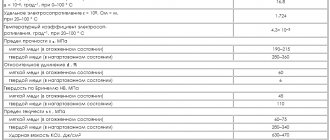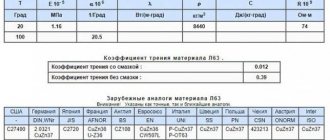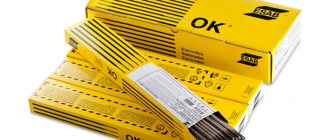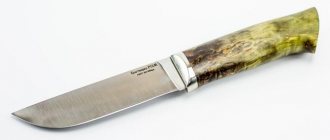Technical copper
In the annealed state, it is quite plastic, but has relatively low strength. The chemical composition of technical grades of copper is determined by GOST 859–41. Technical grades are used in the smelting of copper alloys as a charge material. Technical grade M0 is used in the manufacture of high-purity alloys and current conductors. M1 in the manufacture of semi-finished products obtained by rolling, in the production of high-quality bronzes that do not contain tin. M2 is a technical grade used for the production of bronzes for the production of high-quality semi-finished products that are processed under pressure. The MZ technical grade is in demand for semi-finished products that are produced by rolling, the production of standard quality bronzes and other casting alloys, as well as non-critical electrical contacts (like the M2 alloy). Technical grade M4 is used in the smelting of cast bronzes.
Application area of copper alloys
Copper has low resistivity. This property has provided copper with widespread use in the electrical industry. Conductors, wires, and cables are made from copper. Copper is used in the manufacture of printed circuit boards for various electronic devices. Copper wires are used in electric motors and transformers.
Copper has high thermal conductivity. This ensures its use in the manufacture of cooling and heating radiators, air conditioners, and coolers.
The strength and corrosion resistance of copper served as the basis for the manufacture of pipes from it, which have a wide range of applications: in plumbing, gas and heating systems, in refrigeration equipment, and in air conditioning.
In construction, copper is used in the manufacture of roofs and facade parts of buildings.
The bactericidal properties of copper make it possible to use it in medical institutions as a disinfectant material: in the manufacture of interior parts that people touch the most - door handles, railings, handrails, bed sides, etc.
Copper alloys have no less scope of application.
Bronze (by grade) is used in the production of machine parts: steam and water fittings, critical components, bearings, bushings. Tin wrought bronzes are used to produce meshes used in the pulp and paper industry.
Brass (by grade) is used in the production of machine parts in the field of heating engineering and chemical equipment. Various coils and bellows are made from them. In the automotive industry, brass is used for the manufacture of condenser pipes, pipes, and hardware. In shipbuilding and aircraft manufacturing, brass is also used for the manufacture of parts, condenser pipes, and hardware. Parts of watch mechanisms and printing matrices are made from brass.
Cupronickel MNZhMts is used for the production of condenser tubes for sea vessels operating in the most difficult conditions. Cupronickel MH19 is used for the manufacture of medical instruments, coins, jewelry, and cutlery.
Impurities in copper alloys
Impurities contained in copper (and, naturally, interacting with it) are divided into three groups.
Forming solid solutions with copper
Such impurities include aluminum, antimony, nickel, iron, tin, zinc, etc. These additives significantly reduce electrical and thermal conductivity. The grades that are primarily used for the production of conductive elements include M0 and M1. If the copper alloy contains antimony, its hot pressure treatment becomes significantly more difficult.
Impurities that do not dissolve in copper
These include lead, bismuth, etc. Although they do not affect the electrical conductivity of the base metal, such impurities make it difficult to process by pressure.
Impurities that form brittle chemical compounds with copper
This group includes sulfur and oxygen, which reduces the electrical conductivity and strength of the base metal. The sulfur content of the copper alloy greatly facilitates its machinability by cutting.
Copper grades and their applications
Copper rods. Conventions. GOST 1535-2006.
The symbols of copper rods used in documentation and certificates are standardized according to GOST 1535-2006, “Copper rods”.
Recording a symbol
| Bar | X | XX | X | X | … | … | … | … | GOST 1535-2006 |
| Product type | |||||||||
| Preparation method | |||||||||
| Section shape | |||||||||
| Precision manufacturing | |||||||||
| State | |||||||||
| Section dimensions | |||||||||
| Length | |||||||||
| Copper grade | |||||||||
| Special conditions | |||||||||
| Standard | |||||||||
The following abbreviations are used:
- KR - round
- KV - square
- SHG - hexagonal
- N - normal
- P - increased
- B - high
- M - soft
- P - semi-solid
- T - hard
- A - permissible diameter deviations with symmetrical tolerances
- AB - for processing on automatic machines
- L - soft state of increased plasticity
- F - semi-solid state of increased plasticity
- Y - solid state of increased plasticity
- OK - with cut ends
- C - increased accuracy in curvature
- P - regulated requirements for tensile testing
- HB - regulated requirements for Brinell hardness testing
- HV - regulated requirements for Vickers hardness measurement
- BT - rod in free-winding coils
- BU - rod in coils of layer-by-layer ordered winding
An “X” is placed in place of missing data, except for the length designation and special conditions.
If special conditions are not specified by the consumer in the order, then the rods are manufactured with performance conditions at the discretion of the manufacturer.
Examples of bar symbols
Drawn rod, round, high-precision manufacturing, hard, 10 mm in diameter, of unmeasured length, made of M1 grade copper, intended for processing on automatic machines:
- Rod DKRVT 10 ND M1 AB GOST 1535-2006
Drawn rod, hexagonal, high-precision manufacturing, soft, diameter 19mm, length 3000mm, made of copper grade M2:
- Rod DShGPM 19 x 3000 M2 GOST 1535-2006
Drawn rod, square, of normal manufacturing precision, semi-solid, with a diameter of 10 mm, a multiple of the measured length of 1500 mm, from copper grade MZ:
- Rod DKRNP 10 x 1500 KD MZ GOST 1535-2006
Percentage composition
| Percentage composition of material | |||||||||||||
| Copper alloy grades | Fe | Ni | S | Cu | As | Pb | O | Sb | Bi | Sn | P | Zn | Ag |
| M1 | ≤ 0.005 | ≤ 0.0020 | ≤ 0.004 | 99.9 | ≤ 0.0020 | ≤ 0.005 | ≤ 0.05 | ≤ 0.002 | ≤ 0.001 | ≤ 0.002 | ≤ 0.004 | ≤ 0.003 | |
| M 1р | ≤ 0.005 | ≤ 0.0020 | ≤ 0.005 | 99.9 | ≤ 0.0020 | ≤ 0.005 | ≤ 0.01 | ≤ 0.002 | ≤ 0.001 | ≤ 0.002 | from 0.002 to 0.012 | ≤ 0.005 | |
| M 2 | ≤ 0.05 | ≤ 0.2 | ≤ 0.01 | 99.7 | ≤ 0.01 | ≤ 0.01 | ≤ 0.07 | ≤ 0.005 | ≤ 0.0020 | ≤ 0.05 | |||
| M 2p | ≤ 0.05 | ≤ 0.2 | ≤ 0.01 | 99.7 | ≤ 0.01 | ≤ 0.01 | ≤ 0.01 | ≤ 0.005 | ≤ 0.0020 | ≤ 0.05 | |||
| M 3 | ≤ 0.05 | ≤ 0.2 | ≤ 0.01 | 99.5 | ≤ 0.01 | ≤ 0.050 | ≤ 0.08 | ≤ 0.050 | ≤ 0.003 | ≤ 0.05 | |||
| M 3р | ≤ 0.05 | ≤ 0.2 | ≤ 0.01 | 99.5 | ≤ 0.05 | ≤ 0.03 | ≤ 0.01 | ≤ 0.05 | ≤ 0.003 | ≤ 0.05 | from 0.005 to 0.06 |
Use of copper in medicine
The use of copper in the medical industry can be found quite often. According to the norms of traditional medicine, copper is an extremely important element of human life. In our body, copper is present in a volume of 2 * 10-4% of a person’s total weight. Every day we consume approximately 60 mg of copper with food, but only 2 mg is absorbed, but this is the amount that is the daily norm for an adult. Copper is extremely important in the process of hemoglobin biosynthesis, as well as in maintaining sugar, cholesterol and uric acid levels. In order for the cardiovascular system, brain, and digestive tract to function as expected, copper is needed. With a chronic lack of copper in the human body, the following diseases develop:
- anemia;
- osteoporosis;
- glaucoma;
- psoriasis;
- the heart muscle atrophies;
- a person gets tired quickly and loses weight;
- Cholesterol accumulates in the body.
The richest foods containing copper are:
- Champignon;
- potato;
- Cod liver;
- whole grain;
- oysters and cuttlefish.
Pure copper
Grade M0 contains 99.95% Cu and no more than 0.05% impurities. According to special technical conditions, several grades of vacuum copper and especially oxygen-free pure copper are produced, which is used in the electric vacuum industry. Strips, tapes, rods, and pipes are produced from oxygen-free copper of series A and B. Tapes and rods are made from vacuum pure copper. Rods are produced from pure copper, which is deoxidized with manganese. All these semi-finished products are used in the electrovacuum industry. Oxygen-free pure copper is characterized by a low (-100°C) recrystallization temperature.
Description
M1 copper is used : for the production of current conductors; rental; high-quality tin-free bronzes; cryogenic equipment products; round drawn thin-walled pipes; cold-rolled foil and strip, cold-rolled and hot-rolled sheets and plates for general purposes; wires for the manufacture of metal shielding braids of the PML type, intended for shielding wires and cables; hot-rolled and cold-rolled anodes used for galvanic coating of products; cold-deformed rectangular tape with a thickness of 0.16−0.30 mm, intended for coaxial trunk cables; radiator tapes intended for the manufacture of cooling tubes and radiator plates; drawn pipes of rectangular and square cross-section, intended for the manufacture of conductors for stator windings of liquid-cooled electrical machines; profiles for the manufacture of rotors of submersible electric motors; round welding wire and round welding rods drawn and pressed with a diameter from 1.2 to 8.0 mm, intended for automatic welding in an inert gas environment, submerged arc and gas welding of non-critical structures made of copper, as well as the manufacture of electrodes for welding copper and cast iron.
Note
M1 copper is obtained by melting cathodes. Copper grade M1 in chemical composition corresponds to copper grade Cu-ETP according to Euronorm EN 1652:1998.
Basic properties of copper
Physical properties
In air, copper acquires a bright yellowish-red hue due to the formation of an oxide film. Thin plates have a greenish-blue color when examined through them. In its pure form, copper is quite soft, malleable and easily rolled and drawn. Impurities can increase its hardness.
This is interesting: Inch threads - dimensions, table, GOST with diameters and pitch, designations in mm
The high electrical conductivity of copper can be called the main property that determines its predominant use. Copper also has very high thermal conductivity. Impurities such as iron, phosphorus, tin, antimony and arsenic affect the basic properties and reduce electrical and thermal conductivity. According to these indicators, copper is second only to silver.
Copper has high densities, melting points and boiling points. An important property is also good resistance to corrosion. For example, at high humidity, iron oxidizes much faster.
Copper lends itself well to processing: it is rolled into copper sheets and copper rods, and drawn into copper wire with a thickness brought to thousandths of a millimeter. This metal is diamagnetic, that is, it is magnetized against the direction of the external magnetic field.
Chemical properties
Copper is a relatively low-active metal. Under normal conditions in dry air, its oxidation does not occur. It reacts easily with halogens, selenium and sulfur. Acids without oxidizing properties have no effect on copper. There are no chemical reactions with hydrogen, carbon and nitrogen. In humid air, oxidation occurs to form copper (II) carbonate, the top layer of platinum. Copper is amphoteric, meaning it forms cations and anions in the earth's crust. Depending on the conditions, copper compounds exhibit acidic or basic properties.
Answers to user questions about copper
We will answer several popular questions from users.
Do old TVs have copper?
From 1 old TV you can get from one and a half to two kilograms of copper. This is mainly the winding of transformers and coils.
What is the electronic and electron graphic formula of copper?
Regarding the electronic configuration of the copper atom: 1s2 2s2 2p6 3s2 3p6 3d10 4s1
Graphic formula of copper:
Features of popular copper alloys
Alloy M1 is manufactured in accordance with GOST 859-2014, is a highly plastic and well-processed metal, and has the highest copper content (99.9%). Additional elements include zinc, nickel, phosphorus, iron, arsenic, oxygen, tin, bismuth (total no more than 0.1%). The electrical resistivity is 0.018 μOhm. The alloy can be of two types - hard (M1t) and soft (M1m), they differ in strength and fluidity. Rolled metal is in demand in the automotive and aircraft industries, in the creation of current conductors, cryogenic equipment, wire and rods.
Alloy M2 has a lower copper ratio in the composition (99.7%). The remaining 0.3% comes from nickel, iron, antimony, oxygen, tin, lead, sulfur, and arsenic. This grade is ductile and does not rust, is excellent in pressure processing and is used for the manufacture of copper-based alloys and refrigeration parts.
Alloy M3 is technical copper; it contains the smallest percentage of metal among those presented (99.5%). The same elements as in M2 are used as alloying components, only in a larger proportion (up to 0.5%), which makes this alloy the most affordable. Optimally suitable for metal products that are sold by rolling methods, as well as cast alloys.
Marking according to GOST
There are different markings of copper
Depending on the additives, impurities and their share in the total volume, the alloy has different properties. This could be corrosion resistance, strength, anti-friction effect, etc. The most common are mixtures of copper with aluminum, zinc, manganese, and magnesium. But in industry, variants with other chemicals are also used.
A special table has been developed with copper markings and its characteristics. It is used when it is necessary to determine the composition according to the GOST classification.
- For example, in Mark M00 the copper content must be at least 99.99%.
- M0 grade contains approximately 99.95% copper. The M0b brand contains approximately 99.97% of the main component.
- If copper is designated as M1, this means that its share in the entire composition is about 99.9%.
- If there is a mark M1p, this means that the substance contains 99.9 copper.
- If there is a designation M2, then the copper will be 99.7%, but the M2p brand also has the same concentration of the main component.
- If the brand is written M3 and M3r, then the amount of copper is 99.5%. If the brand is M4, then the amount of the main substance is 99%.
- Despite the fact that the amount of copper in the brands M1 and M1p, M2 and M2p, M3 and M3p is the same, in products with the letter “p” the oxygen content is less and is only no more than 0.01%, but in others it is approximately 0 .05-0.08%. In addition, phosphorus is included in the composition, but its share is not more than 0.04%.
But in a product marked M0b there is no oxygen at all, in contrast to a product marked M0, where the oxygen content is approximately 0.02%.
In most cases, cathode copper or semi-finished copper products are used (this applies to rolled products, wire rods and other products). Features and scope of application depend on the percentage of impurities in the overall product. Different brands may contain 10–50 impurities. Most often, copper is divided into 2 groups:
- Alloys that contain a minimum amount of oxygen - no more than 0.011%. According to GOST they are designated as M00, M01 and M3. They are usually used for conductors or for creating alloys that are characterized by high purity.
- The metal is a refined type that contains phosphorus impurities in the total volume. Designed for general use. According to GOST it is designated as M1f, M2r, M3r. Typically used to create hot and cold rolled foils, pipes and sheets.
To create pure and high-precision metals, only copper of the grade where there is no oxygen is used. This is very important for the cryogenic industry. In other cases, other types of copper are used. For example, the application is as follows depending on the brand:
- M0 and M00 are used in the production of electrical conductive parts and high frequency parts. Typically, such elements are more expensive and are made to order.
- M001b and M001bf are used for copper wire with a small cross-sectional diameter. Also suitable for other wiring and electrical busbars.
- M1 (including M1r, M1re and M1f) are used as conductors for electric current. They are used to create high quality bronze, where the amount of tin is minimal. Usually they make electrodes and rods for welding cast iron and other metals that are difficult to weld.
- M2 (including M2k, M2r) is usually used for parts that are used in the cryogenic industry. Also suitable for cast steel that will be subjected to pressure treatment.
- M3 (including M3r and M3k) is suitable for the production of pressed semi-finished products or flat products. It is also used for wire, which is used for electromechanical welding of cast iron and copper parts.
Biological value for humans
Copper belongs to the category of vital elements, and the body of an adult contains about 100 grams of this metal. A reassessment of the toxicity of this substance was carried out in 2003 by the World Health Organization. Studies have found that copper is not a cause of diseases of the digestive tract, and does not provoke the development of Wilson-Konovalov disease (hepatocerebral dystrophy affecting the liver and brain), as previously thought. Scientists have concluded that a lack of copper is more harmful to human health than its excess.
The bactericidal properties of copper have been known for a long time, and recent studies in this area have confirmed the effectiveness of the metal in the prevention of swine flu and infection by Staphylococcus aureus. In experiments, it was found that 99% of pathogenic bacteria die on a copper surface within 2 hours. Therefore, copper and its alloys are widely used for water disinfection. In Europe, door handles, locks, hinges and railings are made from this metal, which are installed in medical institutions and public places.
Applications
Lead-copper alloys are used to make electrical connectors and mechanical bearings, especially in the automotive industry where high performance and reliability are required. Mechanical bearings may have high lead content. These high lead content alloys are not suitable for welding or soldering.
Processed alloys
Alloys with approximately 2-4% lead are used for copper processing, where the lead content lubricates the copper and makes it easier to process. These include high quality electrical connectors where high current carrying capacity and low electrical resistance are required. These connectors are used in industrial automation and automotive applications. Brass (copper alloyed with zinc) may also contain lead for the same reason.
Cast and sintered alloys
High-strength cast copper alloys typically contain less than 2% lead. Bearing alloys are often cast or sintered onto a steel base. Softer alloys with higher lead content are also used, for example in bushes where matching to the surface opposite the bearing surface is important.
Some casting alloys contain more than 20% lead, but are no longer used due to their toxicity.
Methods for obtaining copper
In nature, copper exists in compounds and in the form of nuggets. The compounds are represented by oxides, bicarbonates, sulfur and carbon dioxide complexes, as well as sulfide ores. The most common ores are copper pyrite and copper luster. The copper content in them is 1-2%. 90% of primary copper is mined using the pyrometallurgical method and 10% using the hydrometallurgical method.
1. The pyrometallurgical method includes the following processes: enrichment and roasting, smelting for matte, purging in a converter, electrolytic refining. Copper ores are enriched by flotation and oxidative roasting. The essence of the flotation method is as follows: copper particles suspended in an aqueous medium adhere to the surface of air bubbles and rise to the surface. The method allows you to obtain copper powder concentrate, which contains 10-35% copper.
Copper ores and concentrates with a significant sulfur content are subject to oxidative roasting. When heated in the presence of oxygen, sulfides are oxidized, and the amount of sulfur is reduced by almost half. Poor concentrates containing 8-25% copper are roasted. Rich concentrates containing 25-35% copper are melted without resorting to roasting.
The next stage of the pyrometallurgical method for producing copper is smelting for matte. If lump copper ore with a large amount of sulfur is used as a raw material, then smelting is carried out in shaft furnaces. And for powdered flotation concentrate, reverberatory furnaces are used. Melting occurs at a temperature of 1450 °C.
In horizontal converters with side blowing, the copper matte is blown with compressed air in order for the oxidation of sulfides and ferrum to occur. Next, the resulting oxides are converted into slag, and sulfur into oxide. The converter produces blister copper, which contains 98.4-99.4% copper, iron, sulfur, as well as small amounts of nickel, tin, silver and gold.
This is interesting: Ejector - what is it? The principle of operation of ejector pumps and their design
Blister copper is subject to fire and then electrolytic refining. Impurities are removed with gases and converted into slag. As a result of fire refining, copper is formed with a purity of up to 99.5%. And after electrolytic refining, the purity is 99.95%.
2. The hydrometallurgical method involves leaching copper with a weak solution of sulfuric acid, and then separating copper metal directly from the solution. This method is used for processing low-grade ores and does not allow for the associated extraction of precious metals along with copper.
Supply
Are you interested in technical and pure copper? The supplier "Auremo" offers to buy technical and pure copper today on favorable terms. Large selection in stock. Full compliance with GOST and international quality standards, optimal price from the supplier. We offer to buy technical and pure copper from specialized warehouses with delivery to any city. Buy today. For wholesale customers the price is preferential.
Buy, favorable price
Technical and pure copper from the supplier "Auremo" complies with GOST and international quality standards, the price is optimal. We have the widest selection of products in stock. Technical and pure copper is always available, the price is determined by the technological features of production without including additional costs. Optimal price from the supplier. Buy today. We are waiting for your orders. We have the best price-quality ratio for the entire range of products. Experienced managers are in touch and will quickly help you buy rolled copper wholesale or in installments. Regular customers can buy rolled copper at a discount.
Source
| M00 | 99,99 |
| M0 | 99,95 |
| M1 | 99,90 |
| M1r | 99,90 |
| M2 | 99,70 |
| M2r | 99,70 |
| M3 | 99,50 |
| M3r | 99,50 |
Copper alloys, their properties, characteristics, grades
The production of copper alloys makes it possible to improve the properties of copper without losing the main advantages of this metal, as well as to obtain additional useful properties.
Copper alloys include: bronze, brass and copper-nickel alloys.
Brass
This is an alloy of copper and zinc. In addition to zinc, it also contains other alloying additives, including tin.
Brasses are corrosion-resistant alloys. They have anti-friction properties to resist vibrations. They have high fluidity rates, which gives products made from them a high degree of resistance to heavy loads. In brass castings, segregation areas are practically not formed, so the products have a uniform structure and density.
Brasses are marked with a set of alphanumeric codes, where the first letter is always L, meaning brass itself. Next comes a digital indicator of the percentage of copper in brass. The remaining letters and numbers indicate the content of alloying elements as a percentage. Brasses use the same letter designations for alloying elements as bronzes.
An example of double brass marking: L85. It stands for “brass with a copper content of up to 85%, the rest is zinc.”
An example of multi-component brass marking: LMtsA57-3-1. It stands for “brass with a copper content of up to 57%, manganese - up to 3%, aluminum - up to 1%, the rest is zinc.”
Bronze
An alloy of copper and tin. However, with the development of technology, bronzes also appeared, in which, instead of tin, aluminum, silicon, beryllium and lead were introduced into the alloy.
Bronze is harder than copper. They have higher strength ratings. They are better suited to metal forming, especially forging.
Marking of bronzes is carried out using alphanumeric codes, where the first letters are Br, meaning bronze itself. Additional letters indicate alloying elements, and numbers after the letters indicate the percentage of such elements in the alloy.
Letter designations of bronze alloying elements:
- A – aluminum,
- B – beryllium,
- F – iron,
- K – silicon,
- Mts – manganese,
- N – nickel,
- O - tin,
- C – lead,
- C – zinc,
- F – phosphorus.
An example of marking tin bronze: BrO10S12N3. It stands for “tin bronze with a tin content of up to 10%, lead – up to 12%, nickel – up to 3%.”
An example of decoding aluminum bronze: BrAZh9-4. It stands for “aluminum bronze with an aluminum content of up to 9% and iron up to 4%.”
Copper-nickel alloys
- Cupronickel is an alloy of copper and nickel. Iron and manganese may be present in the alloy as additives. Special cases of technical alloys based on copper and nickel:
- Nickel silver – additionally contains zinc,
- Constantan – additionally contains manganese.
Cupronickel has high corrosion resistance. It lends itself well to any type of mechanical processing. Non-magnetic. It has a pleasant silver color.
Due to its properties, cupronickel is, first of all, a decorative and applied material. Jewelry and souvenirs are made from it. For decorative purposes it is an excellent substitute for silver.
There are 2 brands of cupronickel available:
- MNZHMts – an alloy of copper with nickel, iron and manganese;
- MH19 is an alloy of copper and nickel.
Copper m1 m2 m3 difference - Metalist's Handbook
- 1 Copper M1 - prices in Moscow. Hard, soft, pressed, annealed copper
- 2 Copper sheet grades M1, M1R, M2, M2R, M3, M3R. GOST 495-92
- 3 Copper pipe (tube)
- 4 Copper
- 5 Article about the types and differences of copper scrap, and the services of the Phoenix-C company
sells bushings, round bars, strips, wire rods, sheets, pipes, hexagons, foil, tires and wire from copper alloy M1 at the lowest prices in the assortment.
All types of products are manufactured in accordance with the relevant GOSTs. If necessary, we sell in pieces/blanks. We also provide related services for metalworking, packaging, storage and delivery of goods to various regions of Russia.
We will provide you with a comfortable full-cycle service. Flexible system of discounts. Your own fleet of vehicles - free delivery within Moscow within 1 day. Delivery to the regions in 2-3 days (free delivery to the transport company terminal).
Copper alloy M1 is produced in accordance with GOST 859-2001. This material contains 99.9% copper, as well as other substances: iron, arsenic, nickel, zinc, sulfur, lead, oxygen, bismuth, tin and antimony. This is a highly plastic material with good corrosion resistance. It is highly processed and is part of the manufacturing process for many other metals.
The key alloying elements here are nickel and phosphorus. Copper alloy M1 can be oxygen-free, cathodic, deoxidized with phosphorus or oxygen. At the same time, according to technical parameters, hard and soft copper are distinguished. This alloy is used primarily in the automotive and aircraft industries, as well as in instrument making.
| Copper pipe M1T | Check availability, sizes and prices in the catalogue. |
| Copper pipe M1M (MM) | Check availability, sizes and prices in the catalogue. |
| Copper busbar М1М (ШММ) | Check availability, sizes and prices in the catalogue. |
| Copper bus M1T (SHMT) | Check availability, sizes and prices in the catalogue. |
| Copper wire M1M | Check availability, sizes and prices in the catalogue. |
| Copper wire M1T (MT) | Check availability, sizes and prices in the catalogue. |
| Copper strip (bus) M1 | Check availability, sizes and prices in the catalogue. |
| Copper tape M1 | Check availability, sizes and prices in the catalogue. |
| Copper tape M1M | Check availability, sizes and prices in the catalogue. |
| Copper tape M1T | Check availability, sizes and prices in the catalogue. |
You can get more information on the current range of M1 copper products we offer from our managers.
Moscow, sh. Enthusiastov, 56, building 44
This material has a number of analogues abroad:
- American alloy C11000;
- English composition C106;
- Italian copper Cu-DHP;
- European copper Cu-ETP;
- German alloy 2.0090.
They have similar technical characteristics and can be used for the same tasks as the M1 brand.
Areas of application
M1 alloy is used for the manufacture of conductive parts and various rolled semi-finished products. The alloy is also used for the production of tin-free bronze compounds. It is popular in the production of cryogenic equipment, and the wire is often used to make rods intended for welding.
This composition is often used in the automotive and aircraft manufacturing sectors for the production of certain equipment components. It can also be used for the production of devices for various purposes - this is facilitated by the flexibility and ductility of the material.
Buy rolled copper M1 at a profit
We offer to buy rolled copper alloy M1 on favorable terms:
- Large selection of assortments and standard sizes.
- Possibility of additional metal processing - cutting, bending, galvanizing, perforation
- Sale in pieces and blanks
- Sales of products, both wholesale and retail.
- Prices without intermediary commissions.
- Various payment methods and terms.
- Flexible system of discounts for wholesale and regular partners.
- Free professional consultations.
- Possibility of pre-packaging the order in the warehouse.
- Fast delivery times. Shipment of paid goods within 24 hours in Moscow.
- Delivery to Russian regions in 2-3 days. If necessary, we will independently calculate and order the services of a transport company. Delivery to the transport company terminal is free.
- Packaging of goods in accordance with customer requirements. It is possible to use several types of packaging: PET polyester tape and PVC polyethylene film.
- Possibility of storing goods in our warehouse until shipment.
- Return of goods in accordance with the legislation of the Russian Federation.







